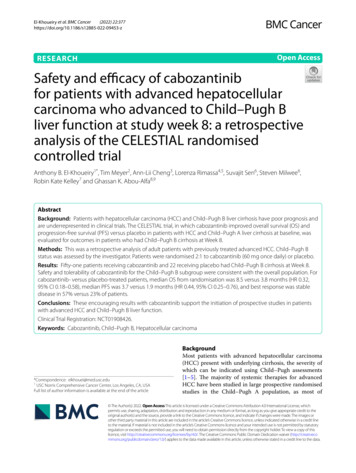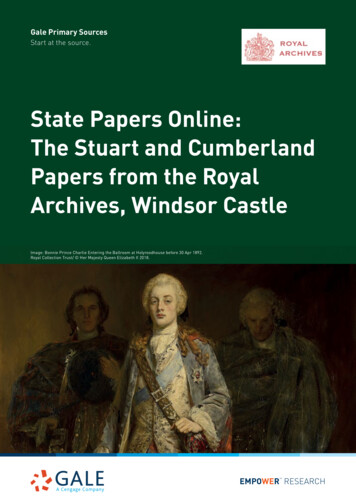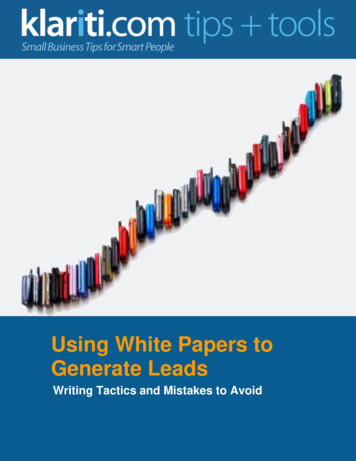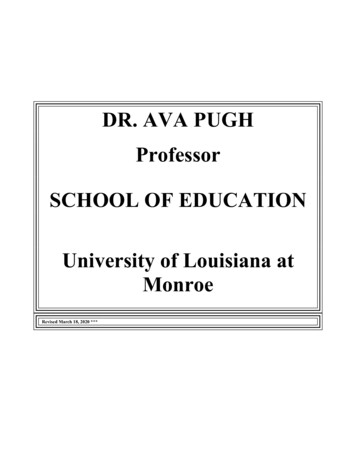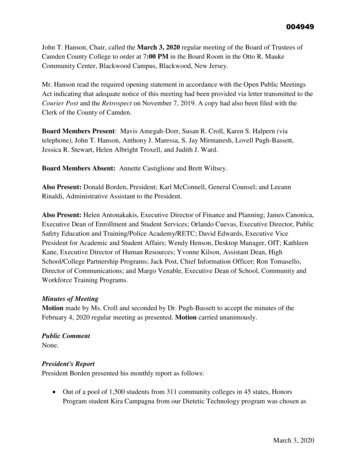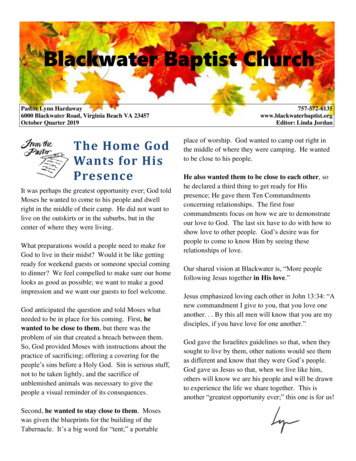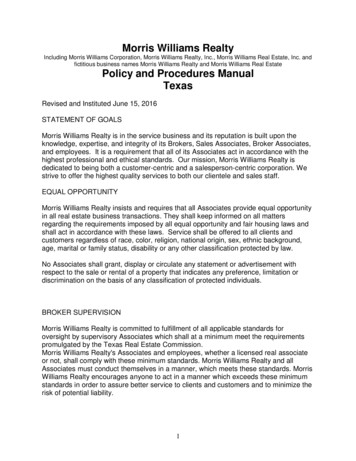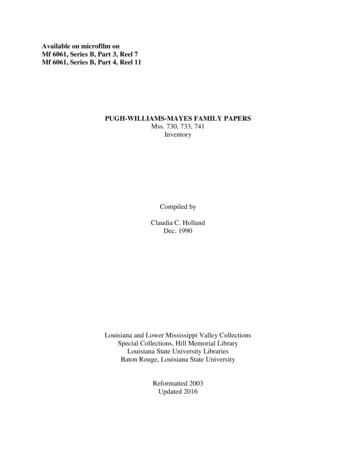
Transcription
Available on microfilm onMf 6061, Series B, Part 3, Reel 7Mf 6061, Series B, Part 4, Reel 11PUGH-WILLIAMS-MAYES FAMILY PAPERSMss. 730, 733, 741InventoryCompiled byClaudia C. HollandDec. 1990Louisiana and Lower Mississippi Valley CollectionsSpecial Collections, Hill Memorial LibraryLouisiana State University LibrariesBaton Rouge, Louisiana State UniversityReformatted 2003Updated 2016
PUGH-WILLIAMS-MAYES PAPERS1844-1933Mss. 730, 733, 741LSU LIBRARIES SPECIAL COLLECTIONSCONTENTS OF INVENTORYSUMMARY . 3BIOGRAPHICAL/HISTORICAL NOTE . 4SCOPE AND CONTENT NOTE . 5SERIES DESCRIPTIONS . 7INDEX TERMS . 8CONTAINER LIST . 9Use of manuscript materials. If you wish to examine items in the manuscript group, please fillout a call slip specifying the materials you wish to see. Consult the Container List for locationinformation needed on the call slip.Photocopying. Should you wish to request photocopies, please consult a staff member. Theexisting order and arrangement of unbound materials must be maintained.Publication. Readers assume full responsibility for compliance with laws regarding copyright,literary property rights, and libel.Proper acknowledgement of LLMVC materials must be made in any resulting writing orpublications. The correct form of citation for this manuscript group is given on the summary page.Copies of scholarly publications based on research in the Louisiana and Lower Mississippi ValleyCollections are welcomed.Page 2 of 9
PUGH-WILLIAMS-MAYES PAPERS1844-1933Mss. 730, 733, 741LSU LIBRARIES SPECIAL COLLECTIONSSUMMARYSize.1.5 linear feet (238 items, 15 v.)Geographiclocations.Louisiana, Tennessee, Texas, MississippiInclusive dates.1844-1933Bulk nce and legal financial papers of the Pugh-Williams-Mayesfamily. Key figures are Richard Lloyd Pugh (1837-1885), a cotton andsugar planter of Lafourche Parish, Louisiana; John Williams; R. B.Mayes; and Mary Williams Pugh. Also includes 15 manuscripts volumescontaining financial information.Restrictions onaccess.No restrictions.Relatedcollections.Alexander Franklin Pugh Papers (Mss. 354)Francis and William Scott Pugh Wills (Mss. 1077)Josephine Nicholls Pugh Civil War Account (Mss. 2618)Mrs. Mary W. Pugh Papers (Mss. 897, 1055)Thomas Pugh Succession Document (Mss. 779)Welman F. Pugh Diary (Mss. 2113)Col. William W. Pugh and Family Papers (Mss. 2052)W. W. Pugh and Family Plantation Records (Mss. 740, 753)Mrs. W. W. Pugh, Jr. Civil War Account (Mss. 1756)Pugh Family Genealogical Records (Mss. 2747)Copyright.Physical rights are retained by LSU Libraries. Copyright of the originalmaterials is retained by descendants of the writers of these materials inaccordance with U.S. copyright law.Citation.Pugh-Mayes-Williams Papers. Mss. 730, 733, 741. Louisiana and LowerMississippi Valley Collections, LSU Libraries, Baton Rouge, La.Stack location(s).D:98; H:11 (unboxed manuscript volumes);Microfilm 6061, Series B, Part 3, Reel 7; Microfilm 6061, Series B, Part4, Reel 11Page 3 of 9
PUGH-WILLIAMS-MAYES PAPERS1844-1933Mss. 730, 733, 741LSU LIBRARIES SPECIAL COLLECTIONSBIOGRAPHICAL/HISTORICAL NOTERichard Lloyd Pugh (1837-1885) was one of six children of Thomas Pugh (1796-1852) and ElizaC. Foley (d. 1885). Thomas and his half-brothers, Augustin and Whitmell, were among the first“American” planters on Bayou Lafourche, Louisiana. From the time of their arrival in 1820 to1852, the brothers rapidly expanded their land holdings and built a number of sugar plantations.Among Thomas’ holdings were Madewood, Energy, Little Texas, and Pothier plantations. At theoutset of the Civil War, the Pugh family owned 18 plantations and 1,502 slaves.As the youngest of five sons, Richard did not inherit one of Thomas’ plantations. Instead he boughtDixie Plantation and its slaves at a public auction in 1860. In the following year Richard marriedMary Louise Williams and purchased additional land, but this property retroceded to the vendorin 1866.Mary Louise was a daughter of John Williams and Marie Louisa Maquire. R.B. Mayes, son-inlaw of Patrick Maguire and a commission merchant in Tennessee, was a business partner ofWilliams. Mayes and Williams were related by marriage.During the Civil War, Richard served in the Confederate States Army as a private in theWashington Artillery, from March 1862 until June 1863. The Washington Artillery of NewOrleans was an elite corps that won honor in three years’ service with the Army of Tennessee.Many Confederates had fled Bayou Lafourche by the time Union troops invaded the area inNovember of 1862. Richard’s family was no exception as they made their way throughnorthwestern Louisiana and on to Rusk, Texas, where they remained for several months. Richardsecured a furlough in early 1863 to be with his family in Texas, and he subsequently supplied asubstitute to take his place in the war effort. The Pugh family returned to Dixie Plantation andcontinued to operate the sugar plantation through the late 1800s.Additional information regarding the Pugh and related families is available in several publications,most notably The Pugh Plantations, 1860-1865: A Study of Life in Lower Louisiana, BarnesFletcher Lathrop, PhD dissertation, University of Texas at Austin, 1945.Page 4 of 9
PUGH-WILLIAMS-MAYES PAPERS1844-1933Mss. 730, 733, 741LSU LIBRARIES SPECIAL COLLECTIONSSCOPE AND CONTENT NOTEThe Pugh-Mayes-Williams Family Papers consist of correspondence, legal and financialdocuments, and financial manuscript volumes. Four key figures in the papers are Richard LloydPugh, John Williams (Pugh’s father-in-law), Mary Louise Williams Pugh (Pugh’s wife andWilliams’s daughter), and R. B. Mayes (related to Williams by marriage).Letters from R. B. Mayes to John Williams detail partnership agreements, accounts and purchases,the settlement of Patrick Maguire’s (Mayes’ deceased father-in-law) estate, and personalinformation. Williams’ financial difficulties throughout the 1850s are evident in thecorrespondence from Mayes, who refuses to seek additional endorsement from his creditors toaugment Williams’ income. On several occasions there is mention of Williams being forced to sellhis plantation to cover his debts. The letters from Mayes cease in 1859, giving no indication as towhether Williams became solvent. However, Williams continued to operate his plantation andpurchase slaves, as evidenced by the 1861 slave sales receipts.Letters written during the Civil War by Mary Pugh to husband Richard mention the capture ofBaton Rouge by Federal forces, the threat of gunboats shelling the city, and rumors about thebattles at Vicksburg, Jackson, and Port Hudson. The flight of Mary, her father, other families, andtheir slaves from the Bayou Lafourche area through northwestern Louisiana and into Texas isdescribed by Mary. Mary also discusses the behavior of the slaves during this trek.Richard Pugh’s letters to Mary cover the period immediately preceding their marriage through thewar years. His was letters, written from camps in Louisiana (Camp Moore), Mississippi (Corinth,Canton), and Tennessee (Chattanooga, Pikesville, Murfreesboro), detail camp life, skirmishes,troop movements, battles, and personal hardships. Pugh occasionally mentions General Bragg andBreckenridge in his letters.Correspondence from relatives and friends of the Pughs discuss problems associated with laborers,the war, securing supplies, corps, and personal issues. An 1861 letter appears to have been writtenfor Hannah Blair, a slave in Jonesborough, Tennessee, by Mrs. H.H. Gallegher. Blair was replyingto her husband, also a slave, whose “Master” had written a letter for him to Hannah.Legal documents include business agreements, partnership indentures, a copy of Patrick Maguire’swill and a codicil to it, the judgment of Martha Maguire et al. vs. John Williams et al., landpurchases and deeds, and a rental agreement between C. C. Chamberlin and John Williams, thelatter of whom rented two “plantations” (actually farms) from Chamberlin during 1864. A foldercover with the marriage dates of John Williams and Marie Louisa Maguire (Dec. 12, 1837) andRichard L. Pugh and Mary Louise Williams (Feb. 7, 1861) typed on it, and an undated genealogyof the Pugh family are also included.Military documents of the Civil War period include a 20,000.00 bond (two copies) for John Pottsas Brigade Quartermaster and a special order of Louisiana Governor Thomas Moore relievingPotts from duty as quartermaster.Page 5 of 9
PUGH-WILLIAMS-MAYES PAPERS1844-1933Mss. 730, 733, 741LSU LIBRARIES SPECIAL COLLECTIONSSeveral slave bills of sale are present, providing color, age, and, occasionally, work skills of eachslave bought by Pugh from 1859 through 1861. These slaves were purchased in New Orleans fromslave traders from Florida, Louisiana, Missouri, and South Carolina.The financial papers are predominantly accounts and receipts for goods and services purchased byRichard L. Pugh. However, the early materials (1847-1860) reflect the accounts, purchases, loans,and notes of John Williams. Records of Williams’ account with R. B. Mayes list the quantity, cost,and date of items purchased from Mayes.The financial papers of the war period include Confederate military requisitions for salt and beefsent to Richard L. Pugh at the Natchez Salt Works or in Texas. Requests for salt were also madeby citizens in Kickapoo and Ironworks, Texas, and other places. Receipts (or requisitions from theConfederate Quartermaster of the Fourth District) for bacon and corn tithes (tax in kind) submittedby Richard Pugh or John Williams, both (at this time) of Cherokee County, Texas, are included.The financial manuscript volumes (15) consist of a memorandum book, a payroll book, a daybook,two record books, two cashbooks, two journals, and six ledgers. The memorandum book appearsto have been used by Tom Brady during two periods, 1859 to 1861 and 1863 to 1865. Brady, whoapparently worked for the Pughs, recorded daily the number of the family for whom he worked.He also made notes occasionally in the memo book.Richard Pugh recorded cash paid to laborers and other activities on Dixie Plantation in the 18701872 journal. The 1891-1892 journal kept by John Williams in Clarksdale, Mississippi, detailspayments made on various accounts and for goods and services. Cash paid to laborers and forplantation purchases was notedin the cashbooks and the payroll book (Williams), whereas thedaybook (Pugh) was used more specifically to keep track of the debits and credits of individuallaborers. The record books outline the mortgages and notes owed by John and Maria Williams atLeighton Plantation.The ledgers reflect the expenditures and credits of laborers and other activities on Dixie Plantationin the 1870-1872 journal. The 1891-1892 journal kept by John Williams in Clarksdale, Mississippi,details payments made on various accounts and for goods and services. Cash paid to laborers andfor plantation purchases was noted in the cashbooks and the payroll book (Williams), whereas thedaybook (Pugh) was used more specifically to keep track of the debits and credits of individuallaborers. The record books outline the mortgages and notes owed by John and Maria Williams atLeighton Plantation.The ledgers reflect the expenditures and credits of laborers, cotton factor records, and personalaccounts of John Williams and Richard Pugh. One of these volumes is inscribed “SettlementLedger”, indicating the final credit or debit standing for each laborer or tenant employed by theplantation owner. These ledgers, which may be linked to Maguire, Leighton, Dixie, or Mascotplantations, also reflect payment or credit received for cotton and sugar sales.Page 6 of 9
PUGH-WILLIAMS-MAYES PAPERS1844-1933Mss. 730, 733, 741LSU LIBRARIES SPECIAL COLLECTIONSSERIES DESCRIPTIONSSeries I. Correspondence, 1845-1889 (83 items).Includes personal and business correspondence of Richard L. Pugh, John Williams, R. B. Mayes,and Mary Pugh. Additional correspondence from friends and other members of the family.Series II. Legal documents, 1844-1889, undated (39 items).Documents include partnership and rental agreements, Patrick Maquire’s will, land transfers, andgenealogical information on the Pugh family.Series III. Financial papers, 1847-1933 (161 items).Accounts of and receipts for goods and services purchased by Richard L. Pugh and family. Earlymaterials (1847-1860) reflect the expenditures and accounts of John Williams, particularly withR. B. Mayes. Additional items include requisitions for salt, receipts for tax in kind (corn andbacon) submitted by Pugh and Williams, and steamboat freight receipts.Series IV. Financial manuscript volumes, 1847-1895 (15 volumes).A memorandum book, a payroll book, a daybook, two cashbooks, two record books, twojournals, and six ledgers were used to record financial assets and debits of Dixie and Leightonplantations, as well as the individual accounts of John Williams and Richard Pugh. Many ofthese volumes reflect the expenditures and credits of laborers on these plantations.Page 7 of 9
PUGH-WILLIAMS-MAYES PAPERS1844-1933Mss. 730, 733, 741LSU LIBRARIES SPECIAL COLLECTIONSINDEX TERMSMaterials about:Agricultural laborers – LouisianaConfederate States of America.Army. Artillery.Confederate States of America – EconomicconditionsDixie Plantation (La.)Freedman - LouisianaLeighton Plantation (La.)Louisiana – History – Civil War, 1861-1865Maguire FamilyMaguire Plantation (La.)Mascot Plantation (La.)Mayes, R. B.Merchants – LouisianaPlantations – Louisiana – Lafourche ParishPugh FamilyPugh, Mary WilliamsPugh, Richard Lloyd (1837-1885)Reconstruction – LouisianaSlaves – LouisianaWilliams FamilyWilliams, JohnCan be found in:Series I, IV; Folder 3; Volumes 1-9, 11-13Series I-III; Folders 3-6, 10Series I, III; Folders 3-5, 10Series IV; Volume 4Volumes 1-4 6-9, 13, 15Series IV; Volumes 14-15Series I-IV; Folders 3-6, 9-10; Volumes 12, 15Series I-II, IV; Folders 1-2, 6Series II, IV; Folder 13Series IV; Volumes 11Series I-II, IV; Folders 1-2, 6, 8; Volumes 1-2,6, 8; Volumes 1-2, 5, 10-11, 13-15Series I-IV; Folders 1-2, 6, 8; Volumes 1-11,13-15Series I-IV; Folders 1-13; Volumes 1-15Series I-IV; Folders 1-13; Volumes 3-4, 6-8,12Folders 3-6, 9-13Series I-IV; Folders 3-7, 9-13; Volumes 3-4, 68, 12Series IV; Volumes 4, 6-8, 15Series I-II; Folders 3-5, 7Series I-IV; Folders 1-3, 6, 8-12; Volumes 1-2,5, 9-11, 13-15Series I-IV; Folders 1-2, 6, 8-12; Volumes 1-2,5, 9-11, 13-15Page 8 of 9
PUGH-WILLIAMS-MAYES PAPERS1844-1933Mss. 730, 733, 741LSU LIBRARIES SPECIAL COLLECTIONSCONTAINER 8-13D:982Volumes1-4D:9836-7, 9, 13D:9848, 12, 14-15H:11Unboxed5, 10, 11Contents (with dates)Correspondence, 1845-1889 (Series I).Legal documents, 1844-1889 (Series II).Financial papers, 1847-1933 (Series III).Financial manuscript volumes, 1870-1872 (Volume4), 1882-1884 (Volume 3), 1891-1892 (Volume 1),1893-1900 (Volume 2) (Series IV).Financial manuscript volumes, 1868-1870 (Volume6), 1871-1882 (Volume 7), 1883-1887 (Volume 13),1888-1889 (Volume 9) (Series IV).Financial manuscript volumes, 1847-1849 & 18521870 (Volume 15), 1855-1857 (Volume 14), 18591861 & 1863-1865 (Volume 12), 1873-1876(Volume 8) Series IV).Financial manuscript volumes, 1891-1892 (Volume5), 1891-1892 (Volume 10), 1892-1895 (Volume11) (Series IV).Page 9 of 9
Baton Rouge, Louisiana State University Reformatted 2003 Updated 2016 . PUGH-WILLIAMS-MAYES PAPERS Mss. 730, 733, 741 1844-1933 LSU LIBRARIES SPECIAL COLLECTIONS Page 2 of 9 CONTENTS OF INVENTORY . Williams's daughter), and R. B. Mayes (related to Williams by marriage).
